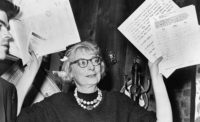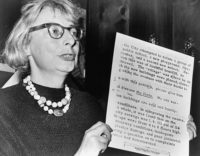In counterpoint to last February’s three-venue series of Robert Moses retrospectives, New York City’s design mavens are now revisiting Jane Jacobs, whose writings about urban life came to symbolize the opposite of Moses’ own approach to planning cities. Manhattan’s Municipal Art Society (MAS) is using the late community organizer and theorist as the touchstone for an inquiry into New York City’s current character.
Jacobs made her name in the early 1960s by helping organize a grassroots campaign to protect historic buildings and neighborhoods from destruction—most notably Greenwich Village, which lay in the path of an expressway Moses sought to build. The MAS show “Jane Jacobs and the Future of New York,” which opened last week and runs until January 2008, invokes this history to rouse a new generation of community activists. The organization is also hoping for a similar effect from a series of seven talks that kicked off last night with a panel provocatively titled: “Is New York is losing its soul?”
When panelists talked of “soul” they seemed to yearn for variety across neighborhoods. Panelist Rocco Landesman, a Broadway producer, bemoaned a “delibidinization” of the cityscape in which generic national chains displace small businesses and even strip clubs, with their factory-produced marquees and bland facades, look eerily similar to banks. Novelist Tama Janowitz spoke wistfully of the days when clerks at the bodega on her block offered to deliver marijuana—now they sell gourmet oatmeal. And Darren Walker, a vice president of the Rockefeller Foundation, proposed government policies to protect independent retailers. “I want Lenox Avenue to look like Lenox Avenue,” he said, describing a Harlem thoroughfare now chockablock with national chains. “It is possible to apportion, by district, part of commercial rent to remain affordable for local stores.”
Panelists discussed architecture’s role in soul-saving mainly in terms of building height. Moderator Clyde Haberman, a columnist for The New York Times, questioned a current city policy that lets developers build taller in exchange for including affordable housing or public space in their projects. This policy has spurred striking designs from Frank Gehry and other veteran designers, as well as rising stars such as Enrique Norten—many of whom have never worked in New York before. But panelists worried that building so many towers is erasing the rich variety of building types and making ground-floor rents too expensive. Alison Tocci, the president of Time Out New York, declared: “If Mayor Bloomberg were as aggressive about supporting small individuals as he is about big developers, there might be a better balance.”
Touching on this point, an audience member drew applause when she urged city planning officials to “stand for the interests of a broad range of people, not just developers.” Timothy Mennel, project manager of the MAS show, later discussed this idea with RECORD by noting that the city’s Parks Department relies on charrettes and input from civic groups to guide its efforts to transform many run-down parks and former industrial zones into popular and attractive public spaces. But parks, he added, never served as Jacobs’ battleground—they were instead Moses’ original domain.
Future panels, which run through December and are detailed on the MAS’s Web site, mas.org, will consider how blogging, university expansions, online activism, and gentrification—all functions of a newly digital and global economy—affect the cityscape. Befitting an activist who loved urban complexity, the series seems sure to raise a mess of ideas.





Post a comment to this article
Report Abusive Comment